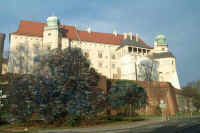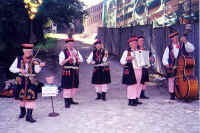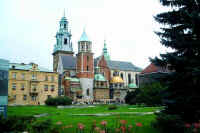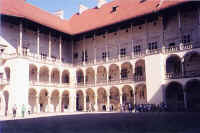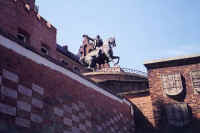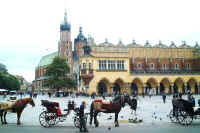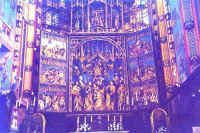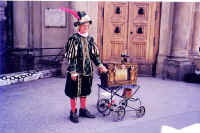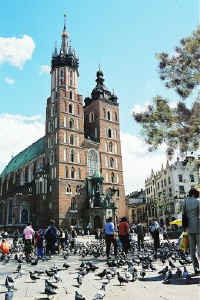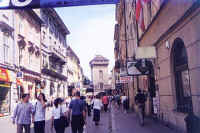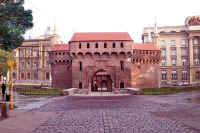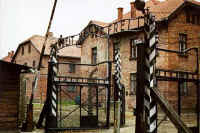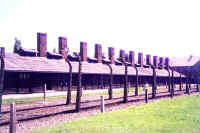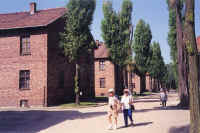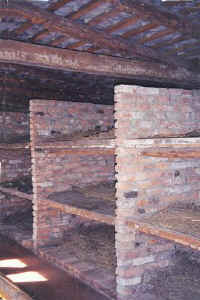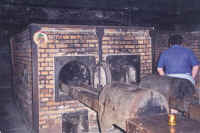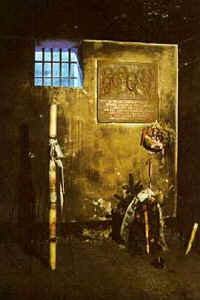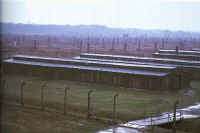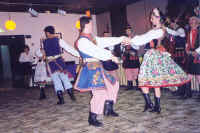|
Krakow
Monday, 20 July. The breakfast buffet at this hotel was nicer and more efficient than it had been in Warsaw.
The bus picked us up for the Krakow city tour at nine, again with Maria as our local guide. She took us to
Wawel Hill, a rocky promontory overlooking the Vistula River. A group of costumed musicians played at the
foot of the hill. Wawel Hill is the site of the Royal Castle, seat of Polish kings for over 300 years until the 17th
century. But the original palace has been greatly modified and added to over the centuries.
The same is true of
the cathedral adjacent to the palace. Our guide said that it dates to the 10th century, and some parts of the
interior dating to the 11th century are still in use. However, what we saw was mostly a 14th century Gothic
cathedral. Not that a 650-year old building is unimpressive! The arcaded courtyard of the palace was
especially beautiful.
In front of the palace is a mounted statue of Tadeusz Kosciuszko, not because of his role in the
American Revolution, but because he was a Polish patriot. In 1794 he led an uprising against the Russians
who had occupied Krakow. While initially successful, the uprising was subsequently crushed. This
unsuccessful revolt led to the third and final partition of Poland (1795), in which Krakow was given to Austria,
and Poland ceased to exist.
Maria led the group down Wawel Hill and into the adjacent Old Town.. We stopped at the prestigious Jagiellonian University, founded in 1364. The beautiful courtyard we visited was built in the year 1400. (See next page.) We continued on to Market Square, with the impressive 13th century Cloth Hall, now filled with stands catering to tourists. There was no time for shopping now, though. We were given just half an hour to browse around before we moved on to St. Mary's Basilica. Construction of this church began in 1221 and took 200 years. It features a huge triptych (42' high by 36' wide when open), carved by Viet Stoss in 1477-1489. We were treated to a special ceremonial opening of the triptych so we could see both the exterior and interior.
Outside we stood near the basilica and waited for noon. Every hour a
trumpeter sounds a warning from a window on each side of the taller church
tower, but he never finishes it. This is a ceremony commemorating the legend of
a brave trumpeter who sounded a warning of a Mongol attack (a common occurrence
in Poland for centuries). His throat was pierced by a Mongol arrow as he played.
Considering the lateness of his warning (the Mongols were already in the center
of town) and the height of the tower, I was rather skeptical about the
accuracy of the legend.
We walked out of Old Town past a 14th century tower in one of the few remaining sections of the old
city walls. Most of the old fortifications were blown up by the Austrians to prevent their use against them. Just
beyond the old wall was a reconstruction of a 16th century barbican. The temperature was in the 90's and we
were wilting in the sun. The air conditioned bus was a welcome relief. The bus got us back to the hotel about
12:45, leaving little time for lunch before the 2 o'clock tour to Auschwitz. Katie solved that by greeting us in
the lobby with jelly donuts and black current juice, a potent combination.
It took nearly an hour to get to Auschwitz (Oswiecim). Before the German invasion in 1939, this was a Polish army barracks with 40 brick buildings. The Germans found it ideal for use as a prison, first for prisoners of war, then for political prisoners. It wasn't until 1942 that it became a death camp for Jews. Since 1947 it has been a museum. We passed through the main gate, with its notorious "ARBEIT MACHT FREI" slogan ("Work makes free."), and past the imposing camp kitchens. There was a work camp at Auschwitz, but the vast majority of people were stripped, shorn, and gassed immediately on arrival. Even among those selected as fit to work, most died of starvation or disease within a few months. It is estimated that two million people died at Auschwitz, most of them Jews. We walked through several exhibits housed in the old brick barracks. There were huge stacks of shoes, brushes, eye glasses, suitcases, and clothes. It was hard to hold back the tears when viewing a display of little children's and babies' clothes. The Russians who liberated the camp in January 1945 also found seven tons of women's hair, two tons of which is still on display. The exhibits included examples of life in the barracks and some of the triple bunks where prisoners slept, head to toe, six to a bed about five feet wide. We also saw the special torture cells, including the one where Father Kolbe died. He was squeezed into a small cell with dozens of others, standing so pressed together that even when they all had suffocated they couldn't fall down. We visited a gas chamber, designed to look like a communal shower, and the ovens where the bodies were cremated.
After a 20-minute film about the camp, the bus took us to Birkenau, another main camp. (Auschwitz included three main camps and more than 40 subcamps.) It was incredibly large, but most of the buildings are gone, marked only by the brick chimneys standing like tombstones. We were surprised to see a thriving town situated exactly between Auschwitz and Birkenau. Our bus started back to Krakow after 5:30 p.m. We had been at Auschwitz for two and a half hours. It was more than enough.
We had less than an hour after our return to get ready for dinner at 7:30. This meal was in the hotel. We were entertained by a Polish folk group of four musicians, four dancers, and an older couple who sang. They succeeded in getting most of our tour group out on the floor for various dances. I did the polka with one of the young women, but Jane was having too much fun to take a picture. The group broke up after 9:30, and the two of us managed to change and get ten minutes in the hotel pool before it closed.
Copyright © 2000-2023 DarrellPeck.com All rights
reserved. | |||||||||||||

